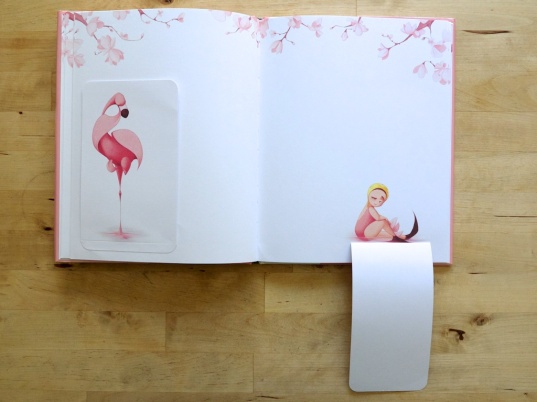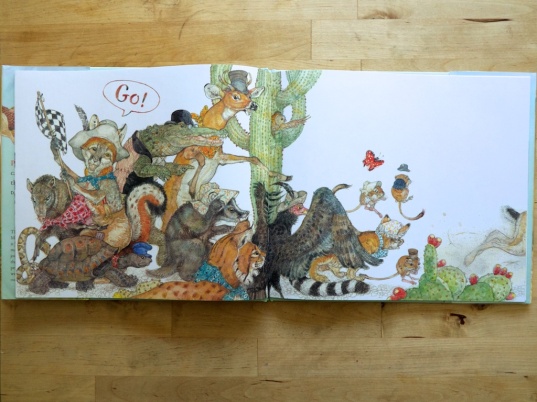Two years ago, while I was acting as a judge for the Cybils and reading even more books than normal in a given year, I noted the inordinate amount of wordless picture books that had come out in 2013. It even turned out to be the Caldecott year for wordless picture books as the 2014 honor awards went to three wordless picture books: Journey, Flora and the Flamingo, and Mr. Wuffles!. It was an unheard-of year for wordless picture books. I even frequently refer to 2013 as “The year of the wordless picture book.” Clever, no?
I’ve discussed wordless books occasionally, the most important for me being South by Patrick McDonnell; but I tend to avoid discussing them as they are intimidating as a reader, and especially as an illustrator. They can be lovely and they can also be frustrating. The tendency to just barrel through each page and not pause too long is even greater because there are no words to guide you. They can be delightful to savor by yourself, but groan-inducing when brought to you by a child with full expectation of you putting on a great ad lib read.
But, a well-executed wordless picture book has gone beyond creating lovely pictures and has buried a story so deep that words cannot express it. The illustrations must do double-duty. They must draw you in, yes with their actual drawn nature; but also with their ability to tell the story with every detail, every expression, every movement and page turn.
I do not have what I would consider the ultimate grasp on how to read a wordless picture book, but I thought I would share a few pointers I have gleaned to help make them less intimidating and perhaps invite you to experience them more fully. I plan on sharing a wordless picture book review every Wednesday for a while, and so I hope this serves as an intro on how to approach all the amazing picture books that come out “quietly.” I took a ton of pictures from the cast of 2013 wordless picture books, so I am going to illustrate my reading tips using those books. Taking a cue from 6 of the stellar wordless books from 2013, here are my 5 tips to reading a wordless picture book:
1. Pace yourself.
Once we learn to read, there is an innate tendency to turn the page as soon as we finish a sentence. This is a terrible habit for reading any picture book, really, as one must always take the time to “read” the illustrations as well as the text. But especially for wordless picture books, I think this is the number one driver of intimidation and fear. Who is going to tell you when to move on? Relax, the author still does. You just have to listen. Don’t fret about spending too much time on one page. Take it all in. Follow the movement and layout of the illustration. You’ll know when it’s time to move on.
2. Ask questions.
This might seem weird at first, but especially when reading to a child, vocalize thoughts and questions about what’s happening. What is the character feeling? Why is that happening? Does that color change mean something? There are a ton of cues in illustrations driving the story along. Look for them with your eyes, and your words.
3. Make up your own text.
Goofy? Yes. But really, when do you ever not feel a little goofy when hanging out with a kid? Embrace it. Now is your time to have fun. It can be as simple as narrating what you see on the page. Or you can create dialog, voices, drama with tone. This story belongs to you now too. Make something of it.
4. Let yourself be moved.
As I stated earlier, a large part of a wordless picture book is expressing things that are difficult to put into words. You know that saying, “A picture is worth a thousand words”? There is a reason that saying exists. An artist can put more emotion into a tiny character’s face sometimes than a whole paragraph of text would accomplish to express it. The illustrated action means something. Notice it. Think about it. Talk about it.
5. Spend time with the illustrations.

Seems like a silly thing to state, but let’s be honest and say that unfortunately way too many people think that anyone can make a “children’s” book. Not only is this completely untrue, but it is even more false when speaking about wordless picture books. The creator of a wordless picture book is a fantastic, risky, and bold artist. They are creating the plot, the setting, the characters, the costumes, the emotions, the drama, …every single thing needed for a complete experience – and they express it all with pictures. And no ordinary picture would be allowed to fly solo in a picture book. Only the best survive. These are some of the most stunning works of art possible, containing levels of subtext within every stroke, mark, and dot. Savor the images. Note the details. Think about the color palette. The experience is always worth it.
There you have it, my very basic list of tips to help when approaching a wordless picture book. While many of them ring true for any picture book you read, I don’t think we naturally give the same amount of time and thought to wordless picture books as we do other books. They require more from us as readers, which is wonderful, but not always desired. And while some of these things feel impossible when a child is your audience, they really aren’t. You are teaching the child to read wholly as you do even one of these steps. Wordless picture books are excellent for non-readers, and especially struggling readers. The story is in the power of the observer. Choose your own adventure in a way. Don’t worry about word or sentence structure, just get lost in the world created for you to read. Reading a book is always more than just stringing letters together; but this is something we all forget much too soon.
Now, what are your tips for reading wordless picture books? And I would love to hear your favorites! I have so many favorites to share. There is no way that I will be wordless about them. Ha!








What a helpful, lovely post!
LikeLike
Thanks for this post! I must admit to being very intimidated by wordless picture books and have found myself rushing through them. I am also finding they are much easier to read with a talking toddler who can be more involved in reading and answering questions.
LikeLike
I have found that I love reading wordless picture books because there are so many levels. I can read the same book over and over and over to kids, but usually find something new – at least the first 10 times. :o)
The tip that has helped me the most is to look through the book quickly – like a skim with the kids to get an idea of the story, then go back and “read” it through with the kids.
Our ultimate favorite book is “Goodnight Gorilla.”
Great post! I’m looking forward to seeing your recommendations.
LikeLike
Guilty! of reading too quickly through a wordless PB. Must slow down and savor. Thanks for the reminder!
LikeLike
And now that I think about it, Peggy Rathmann’s “Ten Minutes Til Bedtime!” was one of our favorites.
And must not forget “Who Made This Cake?” by Chihiro Nakagawa.
Neither are completely wordless, but oh, the hours we spent finding and commenting on the shenanigans of all of those tiny hamsters and the little people making that cake.
LikeLike
So well done! This is an excellent guide and one that will bring more people to the wordless books with their children as they enjoy and write the story in words aloud as they go.
Beautiful, Caryn.
LikeLike
I am so not a fan of reading wordless books together out loud. In my opinion, they are absolutely perfect for quiet reading time and maybe for talking about together, but I am just way, way uncomfortable trying to read them. 🙂 I did just come across a curriculum for learning languages using them. You basically try to tell the story at whatever level you are at and your teacher interacts with you, supplying missing and better vocabulary and structure. I was intrigued. Thanks for sharing this post at Booknificent Thursday!
Tina
LikeLike
I love this!! I just added each of these books to our library wait list to read with the kids. They naturally ask SO many questions when we read books (even to the point that we can’t get the text read sometimes), so I’m think this will be a delightful surprise and change.
LikeLike
THANKS for this post. I went back and reread or reinterpreted Return by Aaron Becker. It was a slower look and more interesting but still need to take it to the grandkids and have them look at it (3 and 6 years old).
LikeLike
[…] text does. I’d like to continue this process, first by reading a brief article entitled “How To Read a Wordless Book.” The purpose of the article is to provide suggestions on “reading” wordless books with […]
LikeLike
[…] celebrate the beautiful ones I can find. If wordless books tend to make you grimace – start with this post with tips for how to read them. And then join me today in drooling over this simple, yet beautiful story about a child and […]
LikeLike